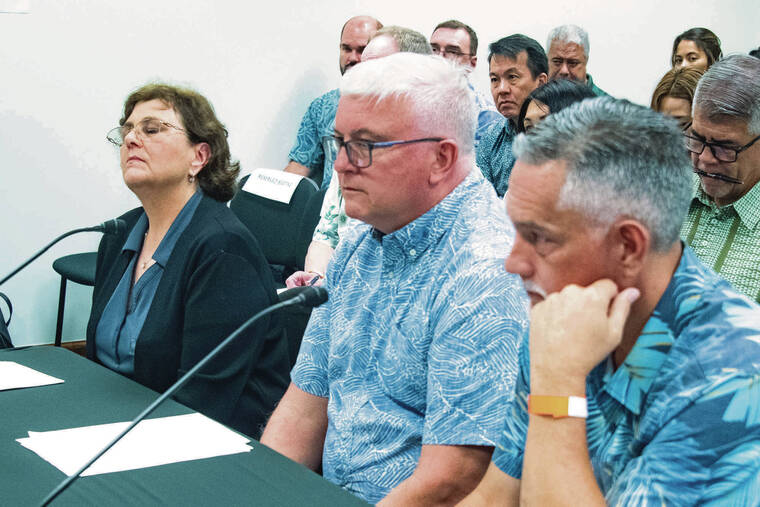HONOLULU — Hawai‘i’s two regulated electrical utilities told a pair of state Senate committees on Thursday that they are trying to do as much as possible as fast as possible with wildfire risk mitigation.
For Hawaiian Electric, this includes spending $117 million this year on such work and seeking $450 million in federal matching grants to help fund $900 million in system improvement projects.
For Kaua‘i Island Utility Cooperative, it includes using drones to inspect equipment and vegetation to address deficiencies, as well as using sound waves and software to better inspect poles for integrity.
The two companies were asked to brief members of the Senate Committee on Commerce and Consumer Protection and the Senate Committee on Public Safety and Intergovernmental and Military Affairs about wildfire mitigation efforts a little over eight months after the Aug. 8, 2023, Maui wildfires, which killed 101 people and destroyed most of Lahaina.
Part of the purpose of the briefing also was to help lawmakers better understand Hawaiian Electric’s request to pass a bill that allows the company to sell low-interest bonds secured by ratepayer revenue to pay for wildfire protection subject to approval by the state Public Utilities Commission.
During the roughly three-hour briefing, Hawaiian Electric and KIUC officials said they are concentrating heavily on wildfire risk reduction planning and implementation.
“We’re not waiting,” said Shelee Kimura, president and CEO of Hawaiian Electric, which has about 471,000 customers on O‘ahu, Maui County and Hawai‘i Island. “We’re taking immediate steps to reduce wildfire risks.”
Practices being rolled out include not automatically reclosing tripped-off circuits until the circuit is verified as safe to reenergize, inspecting equipment with drones and deploying spotters to areas of high fire risk.
Hawaiian Electric also said during the briefing that it is using weather monitors, continues vegetation management under power lines and is still working on a preemptive power shutoff program as a tool of last resort.
The $450 million in federal grant opportunities being pursued involve three separate funding programs, with selections to be made this summer or fall. They are separate from a $95 million grant tentatively awarded to Hawaiian Electric by the U.S. Department of Energy on Aug. 30, 2023, to pay for half of a $190 million climate adaptation transmission and distribution resiliency plan the company proposed to the PUC in June 2022. Terms for using this grant are still being negotiated.
KIUC, a customer-owned nonprofit cooperative, already has used public safety power shutoffs twice since the Lahaina disaster, Beth Amaro, the company’s communications manager, told the two committees.
Amaro also said the company in September hired a consultant to develop a wildfire mitigation plan that is nearing a final draft form.
“It’s a great start, and we actually are already implementing some of the tactics that were identified as part of that plan,” she said.
John Cox, KIUC’s transmission and distribution manager, said drone-based equipment inspection work carried out earlier this year as a pilot project is to be expanded along with pole inspections using sound waves and software.
The new pole inspections were done earlier this year on 1,000 of the company’s roughly 16,000 poles. Typically, inspections were done once every eight years by drilling holes and examining results.
With the new technique, 8 percent of poles tested failed the inspection, necessitating replacement. Now the plan is to use the new technique to inspect every KIUC pole by the end of 2026, Cox said.
Hawaiian Electric, in response to a question, said its pole inspection failure rate is 2 percent. But with 150,000 poles, state Sen. Tim Richards (D, North Hilo-Waimea-North Kona) expressed angst over the potential cost for 3,000 pole replacements and other wildfire mitigation work.
Kimura told the committees that the company will use profits, which totaled $194 million in 2023, to help fund system investments along with debt.
The envisioned debt, Kimura said, includes a short-term credit facility up to $250 million being pursued. But she also said Hawaiian Electric needs the Legislature to allow it to securitize its rate revenue to sell low-interest bonds to help finance wildfire mitigation work because of impacts from the Lahaina Fire.
More than 100 lawsuits have been filed against Hawaiian Electric alleging that it is liable for causing the disaster where gale-force winds blew down power lines.
An official cause of the fire has yet to be determined. Because of the litigation, the company’s credit rating was slashed from investment to junk grade, which has driven up borrowing costs. At the same time, Hawaiian Electric is in a poor position to raise capital by selling stock.
The company has proposed to cap the cost of any bond financing that the PUC allows to be passed on to ratepayers at 5 percent of a typical residential monthly bill. This could allow the company to raise $2.5 billion for use over multiple years.
Jason Benn, Hawaiian Electric chief information officer, said approving securitization could save ratepayers $33 million a year for 30 years.
Two bills remain pending at the Legislature to allow the securitized bond financing for Hawai‘i electrical utilities.
David Bissell, KIUC president and CEO, told the committee that as a co-op the company has access to federal loans that are cheaper than securitized bonds.
There have been suggestions that Hawaiian Electric perhaps should become a customer-owned co-op, but Kimura said that is a difficult prospect because of the company’s size.


